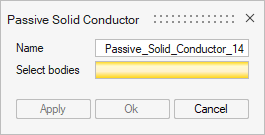Passive Conductor

Introduction
This functionality can be used currently to define some bodies as passive conductors. Defining a body as a passive conductor allows the computation of eddy currents in that body. This will enable the calculation of Joule losses due to these eddy currents in the results requests panel. Skin effect is also simulated using this functionality.
It can be used in Transient Magnetic or AC Magnetic solution to define for instance the squirrel cage in an induction machine or the heated part in an induction heating analysis.
Concerning the magnets modelling with losses computation in Transient Magnetic, the Passive Conductor is not used. Instead, the Magnet losses checkbox in the Magnet Load and Constraint is enabled. For more information, please refer to the page Magnet.
Dialog Box for 3D Transient Magnetic solution

Steps for Transient Magnetic and AC Magnetic solutions
For Transient Magnetic and AC Magnetic solutions, to define a body as passive conductor:
- Assign a Material with a soft magnetic property and an electrical resistivity to the body
- Assign the body to passive conductor load